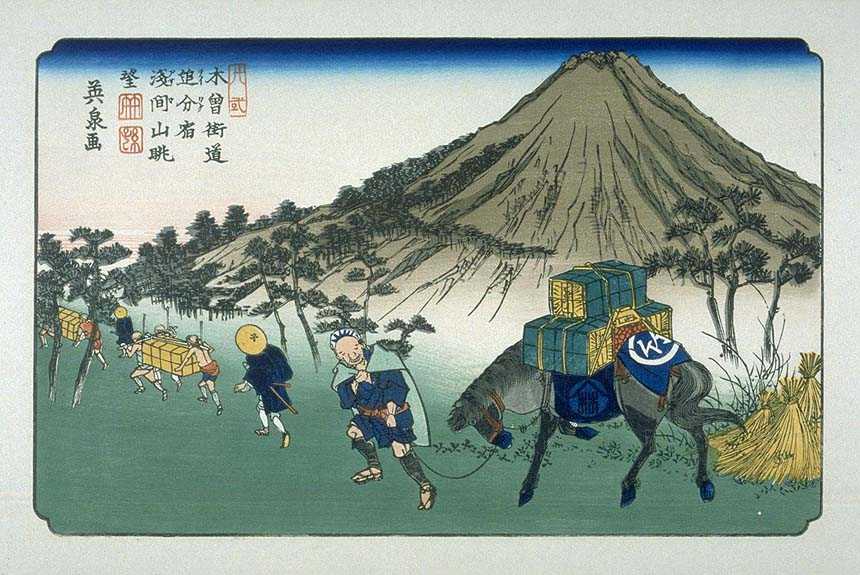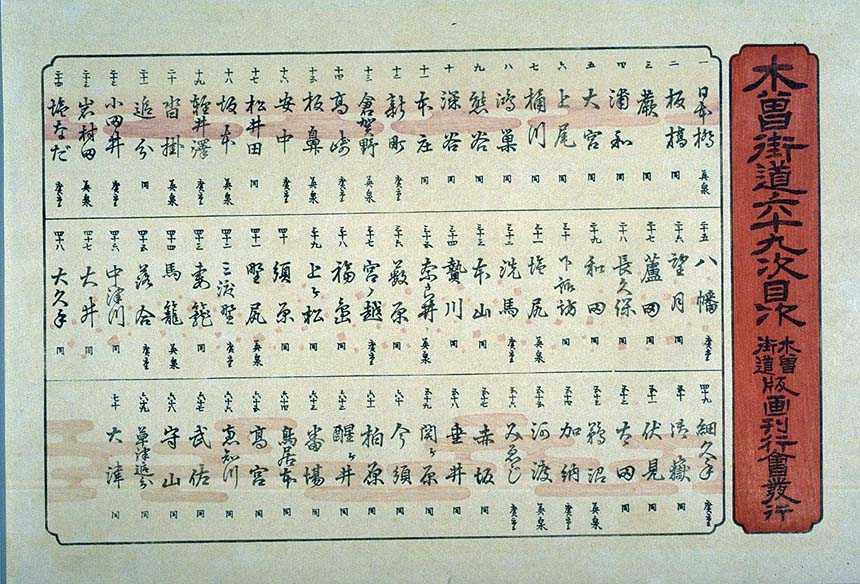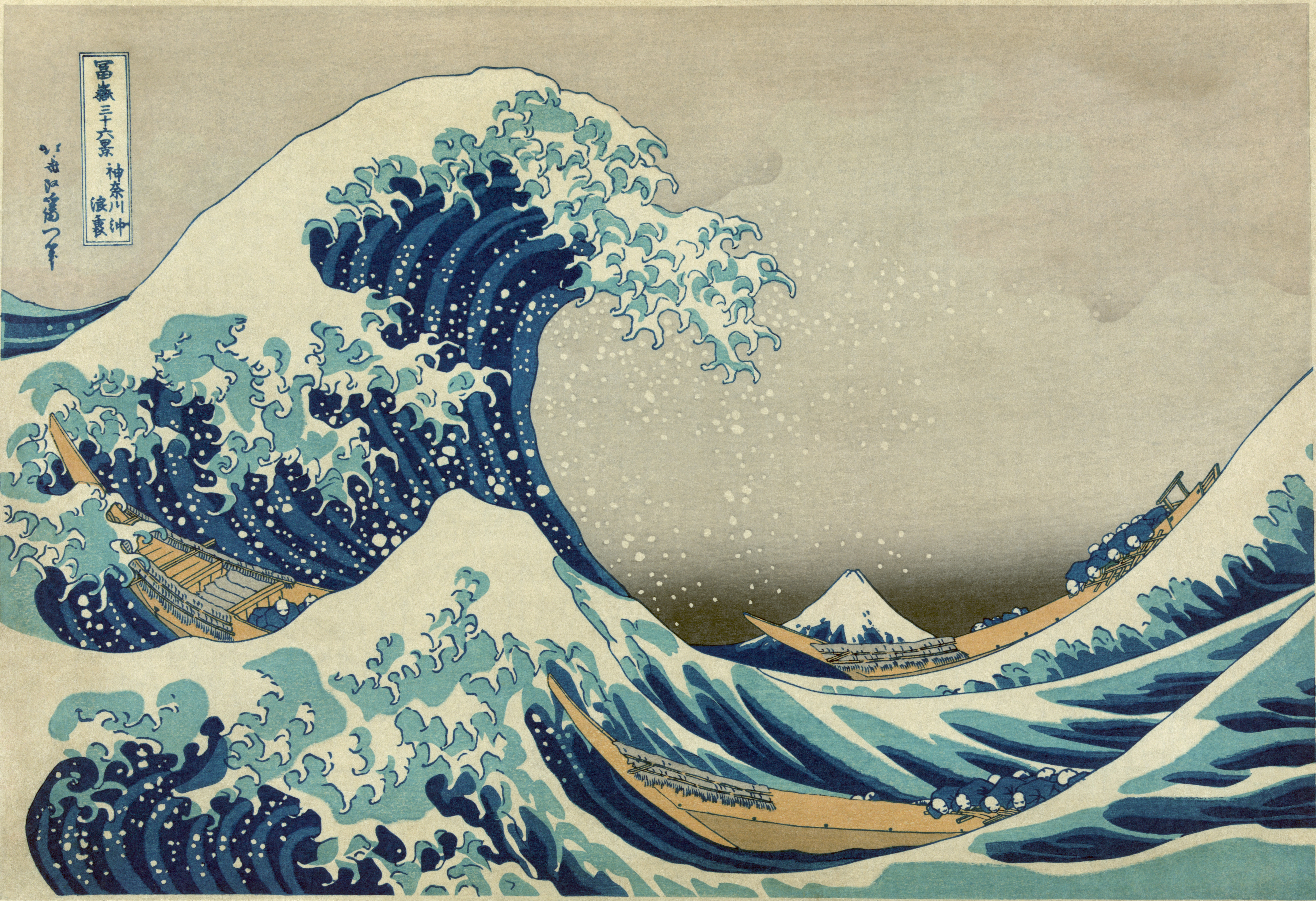|
Hiroshige
or , born Andō Tokutarō (; 1797 – 12 October 1858), was a Japanese ''ukiyo-e'' artist, considered the last great master of that tradition. Hiroshige is best known for his horizontal-format landscape series '' The Fifty-three Stations of the Tōkaidō'' and for his vertical-format landscape series '' One Hundred Famous Views of Edo''. The subjects of his work were atypical of the ''ukiyo-e'' genre, whose typical focus was on beautiful women, popular actors, and other scenes of the urban pleasure districts of Japan's Edo period (1603–1868). The popular series '' Thirty-six Views of Mount Fuji'' by Hokusai was a strong influence on Hiroshige's choice of subject, though Hiroshige's approach was more poetic and ambient than Hokusai's bolder, more formal prints. Subtle use of color was essential in Hiroshige's prints, often printed with multiple impressions in the same area and with extensive use of '' bokashi'' (color gradation), both of which were rather labor-intensive ... [...More Info...] [...Related Items...] OR: [Wikipedia] [Google] [Baidu] |
The Sixty-nine Stations Of The Kiso Kaidō
The or ''Sixty-nine Stations of the Kiso Road'', is a series of ''ukiyo-e'' works created by Utagawa Hiroshige and Keisai Eisen. There are 71 total prints in the series (one for each of the 69 shukuba, post stations and Nihonbashi; Nakatsugawa-juku has two prints). The common name for the Kisokaidō is "Nakasendō" so the series is sometimes referred to as the ''Sixty-nine Stations of the Nakasendō''. It is a follow-up to Hiroshige's ''The Fifty-three Stations of the Tōkaidō'' and he produced 47 of the prints, with Eisen being responsible for the rest.Hiroshige - Kisokaido www.hiroshige.org.uk. Accessed November 1, 2017. The series was published by Iseya Rihei (Kinjudō) from .Forrer The Nakasendō The Nakasendō was one of the Edo Five Routes, Five Routes con ...[...More Info...] [...Related Items...] OR: [Wikipedia] [Google] [Baidu] |
One Hundred Famous Views Of Edo
''One Hundred Famous Views of Edo'' (in ) is a series of 119 ukiyo-e prints begun and largely completed by the Japanese artist Hiroshige (1797–1858). The prints were first published in serialized form in 1856–59, with Hiroshige II completing the series after Hiroshige's death. It was tremendously popular and much reprinted. History Hiroshige produced designs in the style of the Utagawa school, a 19th-century popular style in woodblock prints, much favoured during his lifetime. Increasingly large series of prints were produced. This trend can be seen in Hiroshige’s work, such as ''The Fifty-three Stations of the Tōkaidō'' and ''The Sixty-nine Stations of the Kisokaidō''. Many publishing houses arose and grew, publishing both books and individual prints. A publisher's ownership of the physical woodblocks used to print a given text or image constituted the closest equivalent to a concept of "copyright" that existed at this time. Woodblock prints such as these were produce ... [...More Info...] [...Related Items...] OR: [Wikipedia] [Google] [Baidu] |
Ukiyo-e
is a genre of Japanese art that flourished from the 17th through 19th centuries. Its artists produced woodblock printing, woodblock prints and Nikuhitsu-ga, paintings of such subjects as female beauties; kabuki actors and sumo wrestlers; scenes from history and folk tales; travel scenes and landscapes; Flora of Japan, flora and Wildlife of Japan#Fauna, fauna; and Shunga, erotica. In 1603, the city of Edo (Tokyo), Edo (Tokyo) became the seat of the ruling Tokugawa shogunate. The class (merchants, craftsmen and workers), positioned at the bottom of Four occupations, the social order, benefited the most from the city's rapid economic growth. They began to indulge in and patronize the entertainment of kabuki theatre, geisha, and oiran, courtesans of the Yūkaku, pleasure districts. The term ('floating world') came to describe this hedonistic lifestyle. Printed or painted ukiyo-e works were popular with the class, who had become wealthy enough to afford to decorate their homes wit ... [...More Info...] [...Related Items...] OR: [Wikipedia] [Google] [Baidu] |
Kunisada
Utagawa Kunisada (; 1786 – 12 January 1865), also known as Utagawa Toyokuni III (, ), was a Japanese ukiyo-e artist. He is considered the most popular, prolific and commercially successful designer of ukiyo-e woodblock printing in Japan, woodblock prints in 19th-century Japan. In his own time, his reputation far exceeded that of his contemporaries, Hokusai, Hiroshige and Utagawa Kuniyoshi, Kuniyoshi. Evaluation of Kunisada in art history At the end of the Edo period (1603–1867), Hiroshige, Kuniyoshi and Kunisada were the three best representatives of the Japanese color woodcut in Edo (capital city of Japan, now Tokyo). However, among European and American collectors of Japanese prints, beginning in the late 19th and early 20th century, all three of these artists were actually regarded as rather inferior to the greats of classical ukiyo-e, and therefore as having contributed considerably to the downfall of their art. For this reason, some referred to their works as "de ... [...More Info...] [...Related Items...] OR: [Wikipedia] [Google] [Baidu] |
Thirty-six Views Of Mount Fuji
is a series of landscape prints by the Japanese ukiyo-e artist Hokusai (1760–1849). The series depicts Mount Fuji from different locations and in various seasons and weather conditions. The immediate success of the publication led to another ten prints being added to the series. The series was produced from to 1832, when Hokusai was in his seventies and at the height of his career, and published by Nishimura Yohachi.Calza, p. 30Calza, p. 470 Among the prints are three of Hokusai's most famous: '' The Great Wave off Kanagawa'', '' Fine Wind, Clear Morning'', and '' Thunderstorm Beneath the Summit''. The lesser-known '' Kajikazawa in Kai Province'' is also considered one of the series' best works.Calza, p. 472 The ''Thirty-six Views'' has been described as the artist's "indisputable colour-print masterpiece". History Mount Fuji is a popular subject for Japanese art due to its cultural and religious significance. This belief can be traced to '' The Tale of the Bamboo Cutter ... [...More Info...] [...Related Items...] OR: [Wikipedia] [Google] [Baidu] |
Edo Period
The , also known as the , is the period between 1600 or 1603 and 1868 in the history of Japan, when the country was under the rule of the Tokugawa shogunate and some 300 regional ''daimyo'', or feudal lords. Emerging from the chaos of the Sengoku period, the Edo period was characterized by prolonged peace and stability, urbanization and economic growth, strict social order, Isolationism, isolationist foreign policies, and popular enjoyment of Japanese art, arts and Culture of Japan, culture. In 1600, Tokugawa Ieyasu prevailed at the Battle of Sekigahara and established hegemony over most of Japan, and in 1603 was given the title ''shogun'' by Emperor Go-Yōzei. Ieyasu resigned two years later in favor of his son Tokugawa Hidetada, Hidetada, but maintained power, and defeated the primary rival to his authority, Toyotomi Hideyori, at the Siege of Osaka in 1615 before his death the next year. Peace generally prevailed from this point on, making samurai largely redundant. Tokugawa sh ... [...More Info...] [...Related Items...] OR: [Wikipedia] [Google] [Baidu] |
Bokashi (printing)
''Bokashi'' (Japanese: ぼかし) is a technique used in Woodblock printing in Japan, Japanese woodblock printmaking. It achieves a variation in lightness and darkness (Lightness (color), value) of a single color or multiple colors by hand applying a gradation of ink to a moistened wooden printing block, rather than inking the block uniformly. This hand-application had to be repeated for each sheet of paper that was printed. The best-known examples of bokashi are in the 19th-century ''ukiyo-e'' works of Hokusai and Hiroshige, in which the fading of Prussian blue dyes in skies and water create an illusion of depth. In later works by Hiroshige, for example the series ''One Hundred Famous Views of Edo'', most prints originally featured bokashi such as red-to-yellow-to-blue color sunrises. Techniques Gradations can be created on the blocks themselves using the ' technique, or brushed on by hand using '. They can also be done freehand directly onto a print, without using a printing b ... [...More Info...] [...Related Items...] OR: [Wikipedia] [Google] [Baidu] |
Woodblock Printing In Japan
Woodblock printing in Japan (, ''mokuhanga'') is a technique best known for its use in the ''ukiyo-e'' artistic genre of single sheets, but it was also used for printing books in the same period. Invented in China during the Tang dynasty, woodblock printing was widely adopted in Japan during the Edo period (1603–1868). It is similar to woodcut in Western printmaking in some regards, but was widely used for text as well as images. The Japanese mokuhanga technique differs in that it uses water-based inks—as opposed to Western woodcut, which typically uses oil-based inks. The Japanese water-based inks provide a wide range of vivid colors, glazes, and transparency. History Early, to 13th century Woodblock printing was invented in China under the Tang dynasty, and eventually migrated to Japan in the late 700s, where it was first used to reproduce foreign literature. In 764 the Empress Kōken commissioned one million small wooden pagodas, each containing a small woodblock scroll ... [...More Info...] [...Related Items...] OR: [Wikipedia] [Google] [Baidu] |
Japonism
''Japonisme'' is a French term that refers to the popularity and influence of Japanese art and design among a number of Western European artists in the nineteenth century following the forced reopening of foreign trade with Japan in 1858. Japonisme was first described by French art critic and collector Philippe Burty in 1872. While the effects of the trend were likely most pronounced in the visual arts, they extended to architecture, landscaping and gardening, and clothing. Even the performing arts were affected; Gilbert and Sullivan's ''The Mikado'' is perhaps the best example. From the 1860s, ''ukiyo-e,'' Japanese woodblock prints, became a source of inspiration for many Western artists. These prints were created for the commercial market in Japan. Although a percentage of prints were brought to the West through Dutch trade merchants, it was not until the 1860s that ukiyo-e prints gained popularity in Europe. Western artists were intrigued by the original use of color and ... [...More Info...] [...Related Items...] OR: [Wikipedia] [Google] [Baidu] |
Utagawa School
The Utagawa school () was one of the main schools of ukiyo-e, founded by Utagawa Toyoharu. It was the largest ukiyo-e school of its period. The main styles were bijin-ga (beautiful women) and uki-e (perspective picture). His pupil, Toyokuni I, took over after Toyoharu's death and led the group to become the most famous and powerful woodblock print school for the remainder of the 19th century. Hiroshige, Kunisada, Kuniyoshi and Yoshitoshi were Utagawa students. The school became so successful and well known that today more than half of all surviving ukiyo-e prints are from it. Founder Toyoharu adopted Western-style deep perspective, an innovation in Japanese art. His immediate followers, Utagawa Toyohiro and Toyokuni adopted bolder, more sensuous styles than Toyoharu and specialized in different genres — Toyohiro in landscapes and Toyokuni in kabuki actor prints. Later artists in the school specialized in other genres, such as warrior prints and mythic parodies.Johnson ... [...More Info...] [...Related Items...] OR: [Wikipedia] [Google] [Baidu] |
Tokyo
Tokyo, officially the Tokyo Metropolis, is the capital of Japan, capital and List of cities in Japan, most populous city in Japan. With a population of over 14 million in the city proper in 2023, it is List of largest cities, one of the most populous urban areas in the world. The Greater Tokyo Area, which includes Tokyo and parts of six neighboring Prefectures of Japan, prefectures, is the most populous metropolitan area in the world, with 41 million residents . Lying at the head of Tokyo Bay, Tokyo is part of the Kantō region, on the central coast of Honshu, Japan's largest island. It is Japan's economic center and the seat of the Government of Japan, Japanese government and the Emperor of Japan. The Tokyo Metropolitan Government administers Tokyo's central Special wards of Tokyo, 23 special wards, which formerly made up Tokyo City; various commuter towns and suburbs in Western Tokyo, its western area; and two outlying island chains, the Tokyo Islands. Although most of the w ... [...More Info...] [...Related Items...] OR: [Wikipedia] [Google] [Baidu] |
Toyohiro
, birth name Okajima Tōjiro (1773–1828), was a Japanese ukiyo-e artist and painter. He was a member of the Utagawa school and studied under Utagawa Toyoharu, the school's founder. His works include a number of ukiyo-e landscape series, as well as many depictions of the daily activities in the Yoshiwara entertainment quarter; many of his stylistic features paved the way for Hokusai and Hiroshige (the latter a prodigy who studied under Toyohiro, becoming one of the very finest of all landscape artists), as well as producing an important series of ukiyo-e triptychs in collaboration with Toyokuni, and numerous book and e-hon illustrations, which occupied him in his later years. The ukiyo-e series he produced include the following: * ''Eight Views of Edo'' (several series) * ''Eight Views of Ōmi'' (several series) * ''Newly Published Perspective Pieces'' (''Shinpan uki-e'') * ''Twelve Months by Two Artists, Toyokuni and Toyohiro'' (''Toyokuni Toyohiro ryōga jūnikō''), with ... [...More Info...] [...Related Items...] OR: [Wikipedia] [Google] [Baidu] |











